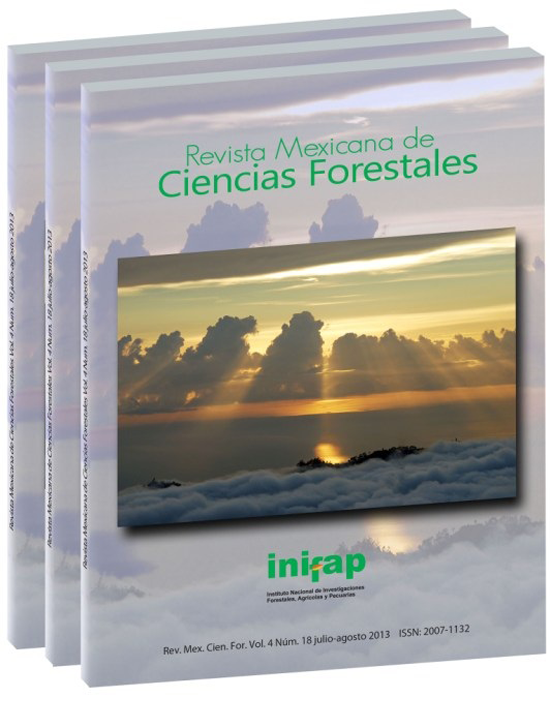TAMAÑO POBLACIONAL Y HÁBITAT DE Megasoma elephas Fabricius, 1775 (COLEOPTERA: DYNASTINAE) EN UN EJIDO DE CAMPECHE
DOI:
https://doi.org/10.29298/rmcf.v4i18.390Palabras clave:
Aprovechamiento, Coleoptera, ecología, Joly-Seber, Lonchocarpus guatemalensis Benth., Megasoma elephas Fabricius, 1775Resumen
Se realizó la caracterización biológica y del hábitat de una población de Megasoma elephas en el ejido La Lucha, Calakmul, Campeche. Se regionalizó la información sobre la historia natural del escarabajo y se propuso una posible tasa de aprovechamiento como base para futuros trabajos. El tamaño de la población se estimó con el modelo de Joly-Seber; para la caracterización del hábitat se establecieron parcelas de 400 m2 alrededor del árbol donde se capturaba a Megasoma, así como transectos lineales de 500 m en el área del ejido, con el método de intercepción de línea. Se obtuvieron 57 individuos y se marcaron 47, con una proporción de sexos de 1.62:1 (machos: hembras). El tamaño de la población estimado fue de 10 individuos, con un máximo de 595 y un mínimo de cero. La tasa de aprovechamiento estimada fue de 25 ejemplares anualmente. Al caracterizar el hábitat se registraron 229 árboles, 18 familias y 52 especies; las 10 más abundantes representaron 67.30% de los individuos muestreados y las dominantes fueron Hampea trilobata, Bursera simaruba, Lasianthaea fruticosa var. fruticosa y Lonchocarpus xuul. Lonchocarpus guatemalensis ocupó el decimoprimer lugar en abundancia y fue la especie en la que se observó 100% de M. elephas. En comparación con datos tomados en años anteriores al estudio, no se determinaron diferencias significativas en la tala, pero sí en el tamaño poblacional. Se efectuaron observaciones del comportamiento del insecto en la región, lo cual aporta nueva información a su historia natural. La tasa de aprovechamiento calculada debe tomarse de forma precautoria, ya que los resultados están basados en una sola etapa del ciclo de vida y en un periodo específico; por lo tanto, se sugiere un monitoreo anual de las poblaciones adultas, así como el estudio de los otros estadios del ciclo de vida de la especie.
Descargas
Descargas
Publicado
Cómo citar
Número
Sección
Licencia
Los autores que publiquen en la Revista Mexicana de Ciencias Forestales aceptan las siguientes condiciones:
De acuerdo con la legislación de derechos de autor, la Revista Mexicana de Ciencias Forestales reconoce y respeta el derecho moral de los autores, así como la titularidad del derecho patrimonial, el cual será cedido a la revista para su difusión en acceso abierto.
Todos los textos publicados por la Revista Mexicana de Ciencias Forestales –sin excepción– se distribuyen amparados bajo la licenciaCreative Commons 4.0 Atribución-No Comercial (CC BY-NC 4.0 Internacional), que permite a terceros utilizar lo publicado siempre que mencionen la autoría del trabajo y a la primera publicación en esta revista. (no permite el uso comercial)
Los autores pueden realizar otros acuerdos contractuales independientes y adicionales para la distribución no exclusiva de la versión del artículo publicado en la Revista Mexicana de Ciencias Forestales (por ejemplo, incluirlo en un repositorio institucional o darlo a conocer en otros medios en papel o electrónicos) siempre que indique clara y explícitamente que el trabajo se publicó por primera vez en la Revista Mexicana de Ciencias Forestales.
Para todo lo anterior, los autores deben remitir el formato de carta-cesión de la propiedad de los derechos de la primera publicación debidamente requisitado y firmado por los autores/as. Este formato debe ser remitido en archivo PDF al correo: editorial.forestal@inifap.gob.mx
Esta obra está bajo una licencia de Creative Commons Reconocimiento-No Comercial 4.0 Internacional.






